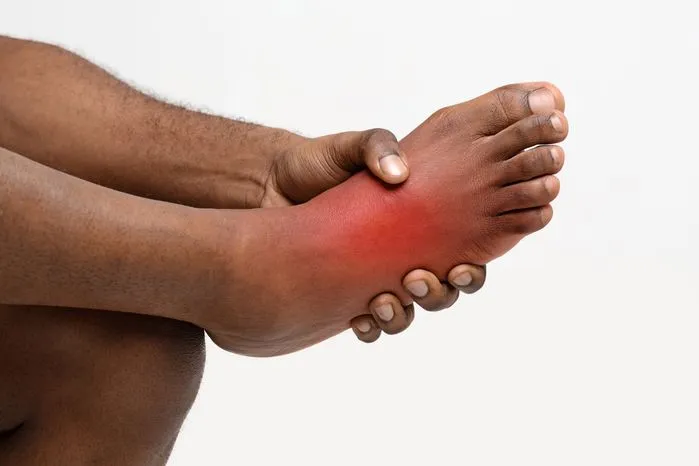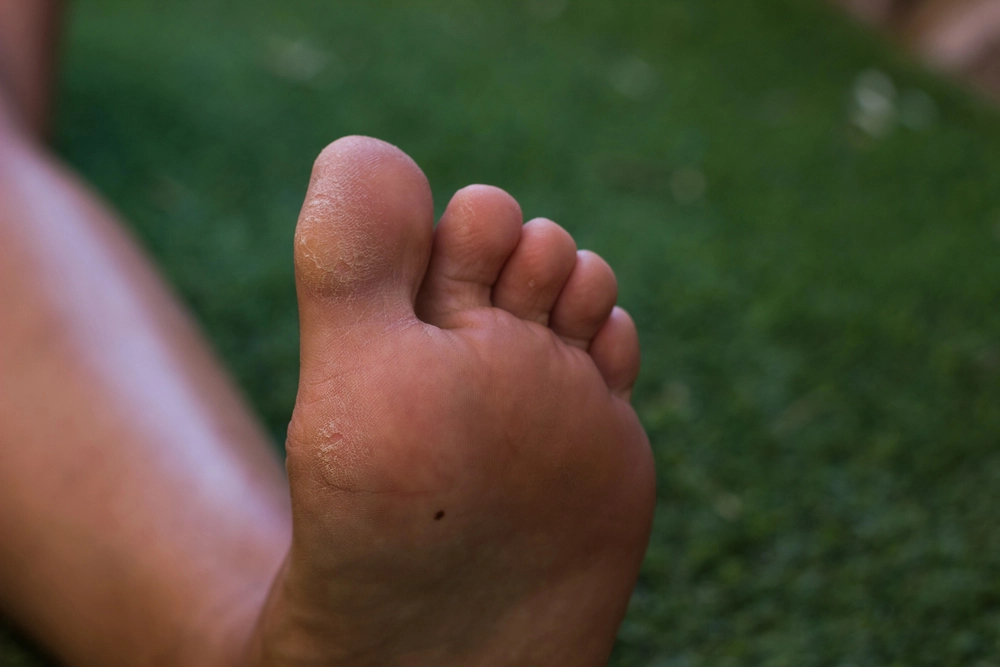
At the Releford Foot and Ankle Institute, we’ve treated thousands of patients struggling with the debilitating effects of gout—and one question consistently comes up: “Which foods are causing my flare-ups?” The truth is that not all high-purine foods affect everyone the same way, and decades of clinical experience have taught us that the top culprits often go overlooked. In this expert guide, we’re not just listing the usual suspects—we’re sharing the 10 foods we most frequently see triggering painful flare-ups in real patients.
Top 5 Takeaways
1. Triggers are personal.
- Watch for patterns in your flare-ups.
2. Common culprits may be in your daily meals.
3. Hydration matters.
4. Prevention beats reaction.
5. Real clinical insight makes a difference.
Understanding Gout
Inflammatory arthritis, known as gout, occurs when high levels of uric acid are present in one's bloodstream. This persistent malady impacts millions globally, manifesting with abrupt, intense bouts of pain, joint redness, and tenderness. Typically, it targets the joint situated at the big toe.
Gout has unique symptoms, including severe joint pain that typically begins in the night's middle, inflamed and reddened joints, alongside restricted joint mobility. As gout worsens, these indicators may occur more frequently.
Identifying Gout Symptoms
Patients often experience intense pain, so severe that even a lightweight bedsheet can trigger discomfort.
Observation may reveal the affected joint feeling warm, and appearing red or purplish. Mostly, these symptoms spring up at night, lasting anywhere from a few hours to several days.
As gout progresses, other symptoms such as limited joint mobility might surface. Also, the presence of tophi – hard deposits of uric acid crystals under the skin – is common.
The Pain of Gout Flare-Ups
Described as a hot, crushing sensation, this pain usually strikes at night and can be so severe that even a light sheet's weight feels unbearable. Such distress, along with the recurring nature of the condition, emphasizes the need for effective gout management.
A comprehensive approach is necessary to understand and manage gout, which includes medication, changes in lifestyle, and dietary modifications.
Culprit #1: Red Meat
These purines, upon breaking down, form uric acid, leading to painful attacks when present in excess.
Opting for alternatives to red meat can significantly diminish gout attack risks. Such foods, including skinless chicken, tofu, and fish, boast lower purine levels, suitable for creating versatile, gout-friendly dishes.
Suspect #2: Seafood's Role
Often favored in many diets, it has a multifaceted role when discussing this condition. This food group, despite myriad health benefits, contains high quantities of triggers to this disease. Bodies break down this substance into uric acid.
Accumulation of uric acid in abundance can lead to the formation of crystals in joints, causing painful gout flare-ups.
Culprit #3: Sugary Beverages
A strong correlation exists between sugar intake, particularly fructose, and an elevated risk of developing gout. Sweet drinks, laden with sugar, contribute significantly to the production of its trigger.
Excessive uric acid triggers the creation of urate crystals in joints, leading to painful inflammation or gout.
Suspect #4: Impact of Alcohol
Specifically, beer can escalate uric acid levels, worsening gout. Yet, the risk fluctuates based on the alcohol type and amount consumed.
Sufferers of this disease find beer particularly problematic due to its high purine content. On the other hand, moderate wine consumption doesn't seem to significantly elevate their risk.
Foods #5-10: Additional Gout Triggers
Organ meats, including liver, kidneys, and sweetbreads, top the offender's list. Red meats, along with game meats, also possess high purine content, hence they can elevate uric acid levels and worsen symptoms.
Adequate water intake helps flush surplus uric acid from the body, proving beneficial in managing the illness.
Dietary Habits to Reduce Your Risks of Triggers
Its management calls for mindfulness of not only the meals to avoid but also of what should be included in your daily meals. Strategic planning combined with nutritional counseling is essential for controlling this condition effectively.
For example, consuming more vitamin C-rich dishes helps lower the levels of triggers to this illness. Choosing low-fat dairy and choosing whole foods also helps.
Lifestyle Recommendations for Its Prevention
Creating better habits, such as choosing to make more physical movements, offers a multitude of advantages. Among them entails reducing your risk of the disease. Imagine choosing to walk to work instead of riding your car. It not only saves you money. It also allows you to exercise.
Another habit to consider is choosing to cook your meals instead of dining out. This is an opportunity to prevent excessive sodium and other unhealthy ingredients in your meals. It also gives you the power to prevent adding ingredients that trigger this condition.
“After treating thousands of gout cases over the past two decades, one truth stands out: it’s not just about what’s on the list—it’s about what’s on your plate. While purines are the usual suspects, we’ve found that hidden triggers like sugary drinks and certain seafood are just as likely to set off a flare. Gout is deeply personal. That’s why we don’t rely on theory—we rely on what we’ve seen work in real patients.”
Supporting Facts and Statistics
At the Releford Foot and Ankle Institute, we've treated thousands of gout cases. Our hands-on experience often mirrors national research, and sometimes goes beyond it. Here’s what we consistently see in real patients, backed by trusted data:
1. Sugary Drinks Trigger Flare-Ups
- Many patients overlook soda and energy drinks.
- Daily consumption is linked to a higher risk of gout.
- We regularly see flare-ups tied to sweetened beverages.
Source: nhlbi.nih.gov
3. Beer Is a High-Risk Alcohol
- Beer has high purine content—a gout trigger.
- Our patients often report worsened symptoms after drinking it.
- Wine may be less risky, but moderation matters.
Source: nhlbi.nih.gov
3. The DASH Diet Helps Lower Uric Acid
- Created for heart health.
- Now shown to reduce uric acid levels.
- We've seen patients benefit from this structured eating plan.
Source: nhlbi.nih.gov
Key Takeaway:
- National research supports what we see every day.
- Personalized dietary choices and hydration matter.
- Gout isn’t just medical—it’s manageable with informed habits.
Final Thoughts & Opinion
We’ve treated thousands of gout cases—and here’s what our experience tells us: its triggers are rarely universal. It’s not just about red meat or shellfish. It’s about patterns, timing, hydration, stress, and individual response.
What We’ve Learned from Real Patients
- Not everyone reacts the same to purine-rich foods.
- Some tolerate salmon well, but flare up after shrimp.
- Others experience attacks after sugary drinks or even late-night eating.
- It’s the combination of triggers—not just a single food—that often causes flare-ups.
Common Mistakes Gout Patients Make
- Relying on generic food charts instead of personal triggers.
- Waiting for a flare-up before adjusting diet or hydration.
- Assuming moderation is safe without tracking symptoms.
- Ignoring hydration and stress can quietly elevate uric acid.
Our Expert Recommendation
- Don’t rely on guesswork—track what you eat and how your body reacts.
- Start managing gout before the pain hits.
- Consult a foot and ankle specialist with real-world experience, not just textbook knowledge.
- Use targeted prevention strategies, not reactive treatments.
Bottom Line
Gout can be chronic, but living in pain doesn’t have to be. With the right knowledge and expert guidance, you can reduce flare-ups and reclaim your quality of life.
Frequently Asked Questions
1. What is gout, and how is it triggered by food?
Gout is a form of inflammatory arthritis caused by the buildup of uric acid crystals in the joints, most commonly the big toe. Certain foods increase uric acid levels in the blood, triggering painful flare-ups.
2. What are the top 10 foods that trigger gout according to medical experts?
The Releford Institute identifies these as the top offenders:
- Red meat (beef, lamb, pork)
- Organ meats (liver, kidneys)
- Shellfish (shrimp, crab, lobster)
- Anchovies and sardines
- Tuna and mackerel
- Alcohol, especially beer and liquor
- Sugary drinks (sodas, sweetened juices)
- High-fructose corn syrup (in processed foods)
- Yeast-rich foods (gravies, extracts, beer)
- Processed meats (sausages, hot dogs, deli meats)
3. Why do purine-rich foods cause gout?
Purines are broken down into uric acid in the body. Foods high in purines lead to elevated uric acid levels, which can crystallize in joints and trigger gout attacks.
4. Can alcohol cause gout flare-ups?
Yes. Alcohol, especially beer, interferes with uric acid elimination and increases purine production, significantly raising the risk of flare-ups, even more so in men.
5. Are all meats equally bad for gout?
No. While red and organ meats are high in purines, lean poultry (like chicken breast) is lower in risk. However, portion control is still important, and moderation is key.
6. How quickly can a gout flare-up occur after eating trigger foods?
Flare-ups can begin within hours to a day after consuming high-purine or sugary foods, especially when combined with dehydration or alcohol intake.
7. Are seafood and fish off-limits for gout patients?
Not entirely. High-purine fish like sardines, anchovies, and tuna should be limited. Low-purine options like salmon (in moderation) may be safer alternatives.
8. Can sugary drinks cause gout, even without meat or alcohol?
Yes. Beverages high in fructose or added sugars (like soda) raise uric acid levels and are strongly linked to gout in both men and women, even without high meat intake.
9. What foods are safe to eat with gout?
The Releford Institute recommends:
- Low-fat dairy
- Whole grains
- Cherries and berries
- Vegetables (even those with moderate purines like spinach)
- Water and herbal teas
- Plant proteins (tofu, legumes in moderation)
10. Can dehydration cause or worsen a gout attack?
Yes. Inadequate water intake reduces uric acid excretion, making crystal buildup in joints more likely. Staying hydrated is one of the most effective ways to prevent gout flares.
11. Is gout only diet-related, or are there other causes?
While diet plays a major role, other risk factors include:
- Genetics
- Kidney dysfunction
- Obesity
- Medications (like diuretics)
- Other metabolic conditions
12. How can I prevent gout flare-ups long-term?
- Limit or avoid the top 10 trigger foods
- Drink 8–10 glasses of water daily.
- Maintain a healthy weight.
- Avoid excessive alcohol
- Follow up with your physician or podiatrist for uric acid monitoring and personalized treatment

















